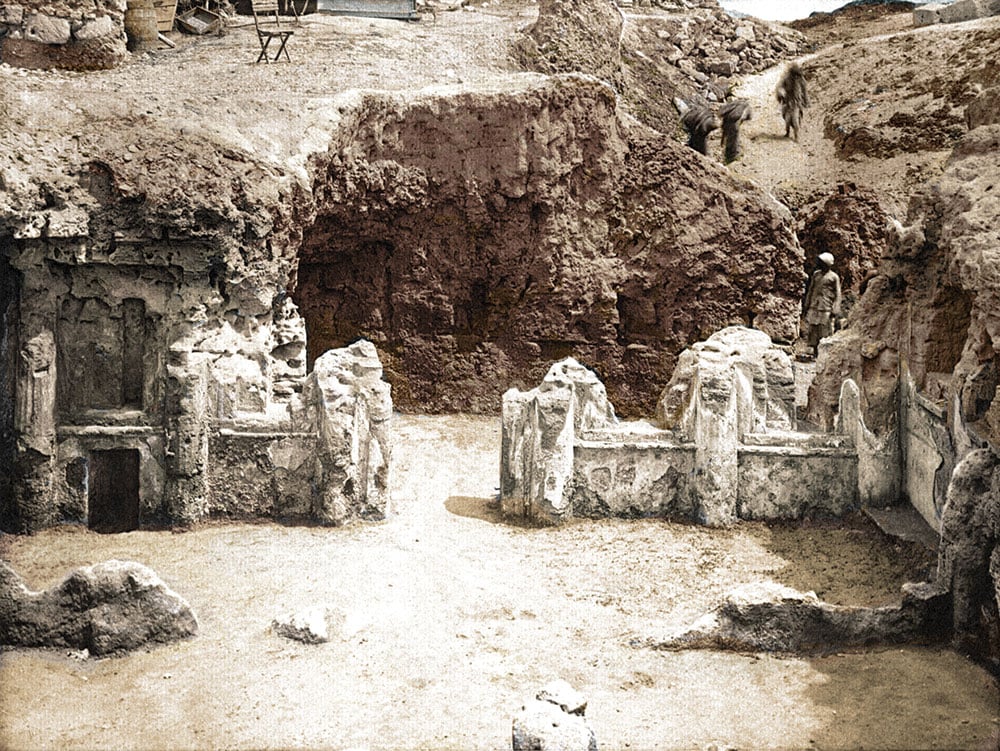

The Shatby Necropolis from the late 4th–3rd century BC is the resting place of Alexandria’s first Greek settlers and the the oldest surviving archaeological site in the Egyptian city.
It was brought back to life after decades of neglect through the Alexandrian Necropolis Project (2020–2023), spearheaded by the Archaeological Society of Alexandria. The necropolis now stands as a visitable monument to the city’s early history—when Alexandria was emerging as a cosmopolitan capital of the Hellenistic world, renowned for its scholarship, architectural splendor, and international influence.
“This is the oldest archaeological site in Alexandria,” affirmed Dr. Kyriakos Savvopoulos, co-director of the excavation and researcher at the University of Oxford, speaking to the Athens-Macedonia News Agency recently.
“Based on the coins, offerings, and architecture, we are witnessing the first generations of Greek settlers—people who built the city but did not yet bear the title ‘citizen of Alexandria.’ They were immigrants, and their place names reflect that—possibly for sentimental reasons.”
Located just outside the ancient city walls, the Shatby Necropolis offers a rare window into early Hellenistic funerary practices in Egypt. Though stylistically reminiscent of Macedonian tombs, it reflects a distinct Egyptian Hellenism—a cultural synthesis visible even in its architecture.

“This is not simply a burial site,” Dr. Savvopoulos explains. “It’s designed like a house. There’s an andron—a dining room for men with banquet couches, a gynaikeion, or women’s chamber, and even wall paintings with false windows half-open to the sky. These are open, social spaces. The dead were placed in undecorated niches, while the living gathered, commemorated, and socialized in rooms that mirrored everyday life.”
Originally uncovered in the early 20th century by Evaristo Breccia, then director of the Greco-Roman Museum of Alexandria, the necropolis was never fully excavated and was later buried under layers of soil and urban neglect. Breccia, only 26 at the time of the initial dig in 1904, preserved what he could, but the excavation remained incomplete.
Decades later, the Archaeological Society resumed his work. “When we returned, we had to pump out five meters of earth—half of it mud,” says Dr. Savvopoulos. “But when we reached the natural floor, offerings and painted tomb façades emerged—things we never expected to find. It was a moment of extraordinary luck and discovery.”
The project identified Underground A, a large, multi-chambered tomb complex, along with two smaller complexes (Underground B and C) and an area of surface-level funerary monuments—likely bases for columns or altars above pit graves.

Unlike the elite tombs of Macedon designed for individuals or families, Shatby was a multi-collective burial space, indicating a community-oriented approach to commemoration. Many of the interred were not particularly wealthy but seemed part of a larger societal structure—perhaps city administrators, artisans, or soldiers tied to Alexandria’s founding institutions.
Evidence includes coins dating back to the Ptolemaic satrapy (beginning 323 BC) and the reign of Ptolemy I, Alexander the Great’s general and successor in Egypt. A tomb mural even depicts a mounted soldier, suggesting a possible connection to the royal guard. Though speculative, these findings hint at proximity to power, if not formal affiliation with the Ptolemaic court.
Behind the cemetery once stood the Royal Squares, the heart of early Hellenistic Alexandria. “The site is so close,” Savvopoulos remarks, “you can see it from the ‘balcony’ of the Royal Squares. It’s likely these same people lived and worked nearby—and chose to build their tombs just beyond the city walls.”

Among the many discoveries: sculptures, glassware, coins, ceramics, and numerous Hadra-type hydriae—distinctive funerary vessels unique to Alexandrian burials. Researchers even found hidden sacristies beneath tombs, with human remains and ritual items, revealing previously unknown funerary customs in the city.
“In some cases, we found skeletons beneath the rooms—women in the gynaikeion, men in the andron—mirroring the division of space in Hellenistic homes,” Savvopoulos notes. “Some tombs included false doors and even portraits of the deceased, often depicted as soldiers or riders, captured in motion. It’s as if they wanted to preserve the vitality of life, even in death.”
“It’s not just a tomb,” says Savvopoulos. “It’s a living monument that tells the story of how a new society was formed—how the first Greek settlers imagined themselves in this new land. In these tombs, we see how they lived, how they died, and how they wished to be remembered.”
Now open to visitors, the Shatby Necropolis invites both scholars and the public to walk through Alexandria’s earliest layers—where architecture, identity, and memory converge.
Related: The Story of Alexandria, the Iconic City of the Ancient Greek World
